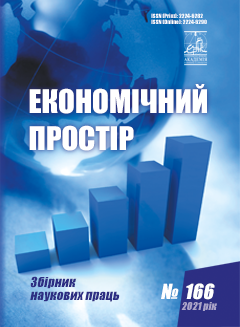INTERPRETATION OF THE INTEGRATED WEIGHTED AVERAGE ASSESSMENT OF THE COMPETITIVENESS OF INNOVATIVE ENTREPRENEURSHIP
Abstract
Managing the competitiveness of the enterprise is becoming increasingly important in market relations and today is the key to successful business. Of particular importance is the assessment of the level of competitiveness of each individual enterprise. In this article, the author proposes an interpretation of the integrated weighted average assessment of the competitiveness of an innovative enterprise. The author believes that it is most correct to calculate and evaluate changes in the competitiveness of a subject of innovative entrepreneurship, taking into account the dynamics of the weighted average. In this case, the evaluative interpretation of the final value should be carried out in the dynamics for many periods (respectively, with increasing dynamics of the integrated indicator of the level of competitiveness of the subject of innovative entrepreneurship to assess the final value as positive, with decreasing dynamics – as negative). Socially oriented indicators that characterize the competitiveness of the subject of innovative entrepreneurship, on the one hand, allow to assess the ability of the subject to create optimal working conditions, and on the other hand, demonstrate the level of social responsibility of the subject to society. Competitiveness of the subjects of innovative entrepreneurship in the social aspect, we consider through indicators: increase of intellectual capital – this indicator allows to estimate ability of the subject to capitalize organizational knowledge and subsequently to transform them into competitive advantages; cost of jobs created – this indicator allows you to assess the effectiveness of employees and the feasibility of creating these jobs; labor activity of employees – this indicator allows you to assess the extent to which employees are motivated to effectively perform their immediate duties; efficiency of social investments – this indicator allows you to assess the effectiveness of investing in the social sphere and the feasibility of investing in staff development.
References
Белл Д. Грядущее постиндустриальное общество. Опыт социального прогнозирования. Москва : Аcademia, 2004. 783 с.
Потенціал підприємства: формування та використання : підруч. / [Н.В. Касьянова, Д.В. Солоха, В.В. Морева та ін.]. Донецьк : Цифрова типографія, 2012. 257 с.
Стадник В.В., Йохна М.А. Інноваційний менеджмент : навч. посіб. Київ : Академвидав, 2006. 463 с.
Чухрай Н. Формування інноваційного потенціалу підприємства: маркетингове та логістичне забезпечення. Львів : Вид-во нац. ун-ту “Львівська політехніка”, 2002. 216 с.
Nonaka I., Takeuchi H. The knowledge – creating company. NY: Oxford University Press, 1995. 120 p.
Bell D. (2004) The future post-industrial society. Experience of social forecasting. Мoscow: Аcademia.
Kasyanov N.V., Solokha D.V., Moreva V.V. (2012) The potential of the enterprise: formation and use. Donetsk: Digital Printing House.
Stadnyk V.V., Jochna M.A. (2006) Innovation Management. Кyiv: Akademvudav (Alma Mater).
Chukhray N. (2002) Formation of innovative potential of the enterprise: marketing and logistics. Lviv: Nat. Lviv Polytechnic University.
Nonaka I., Takeuchi H. (1995) The knowledge – creating company. NY: Oxford University Press.



